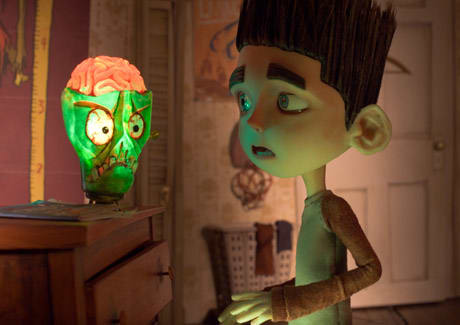Rather than wearing a purple shirt or liking the cause on Facebook, directors Chris Butler and Sam Fell have tackled the subject of bullying with feature-length stop-motion animation ParaNorman, comparing the act to old school witch burnings.
It's a variation on the gothic, Tim Burton, Edward Scissorhands theme and aesthetic, positing titular pre-teen Norman (Kodi Smit-McPhee) as an outsider by default, shunned for his peculiar claims of speaking and communing with the dead. Moreover, his visions eventually manifest delusions of otherworldly gloom and doom, causing him to respond emotionally in social situations, such as a school play.
Able to bond only with socially awkward archetypal bully victim Neil – an overweight kid – his premonitions are ignored by his alienated father, hippie-dippy mother and vapid, texting cliché of an older sister, leaving him to engage with a schizophrenic and manipulate dead bodies, quite vividly, without parental aid.
Essentially this quest to stop an impending curse from coming to fruition propels the narrative forward, manifesting in a surprisingly complex analysis and handling of the core human dread of difference. Of course, since this is an animated film intended to appeal to a broader audience not looking for a depressing look at social hierarchies and the bleakness of human nature, a clumsy comic element exists to distract, and aid, with levity.
It's this tacked on need to please that ultimately hinders the often touching and astute ParaNorman. Jokes about licking a dog's rear end and ghosts popping out of toilets manage to denigrate the material, much like the glib handling of all the secondary characters that merely exist as broad antagonist stereotypes.
This ham-fisted, Saturday morning handling of superficial elements is what distinguishes this exceedingly dark and playfully morbid tale from something like Coraline. Where that film managed to squeeze creativity into every scene, whether aesthetic, thematic or didactic, this one focuses solely on raw subtext.
Still, the unabashed handling of grittier elements such as death and difference is commendable, given the current cultural tendency to placate our younger generation with reassuring concepts and sanctimonious morality.
(Alliance)It's a variation on the gothic, Tim Burton, Edward Scissorhands theme and aesthetic, positing titular pre-teen Norman (Kodi Smit-McPhee) as an outsider by default, shunned for his peculiar claims of speaking and communing with the dead. Moreover, his visions eventually manifest delusions of otherworldly gloom and doom, causing him to respond emotionally in social situations, such as a school play.
Able to bond only with socially awkward archetypal bully victim Neil – an overweight kid – his premonitions are ignored by his alienated father, hippie-dippy mother and vapid, texting cliché of an older sister, leaving him to engage with a schizophrenic and manipulate dead bodies, quite vividly, without parental aid.
Essentially this quest to stop an impending curse from coming to fruition propels the narrative forward, manifesting in a surprisingly complex analysis and handling of the core human dread of difference. Of course, since this is an animated film intended to appeal to a broader audience not looking for a depressing look at social hierarchies and the bleakness of human nature, a clumsy comic element exists to distract, and aid, with levity.
It's this tacked on need to please that ultimately hinders the often touching and astute ParaNorman. Jokes about licking a dog's rear end and ghosts popping out of toilets manage to denigrate the material, much like the glib handling of all the secondary characters that merely exist as broad antagonist stereotypes.
This ham-fisted, Saturday morning handling of superficial elements is what distinguishes this exceedingly dark and playfully morbid tale from something like Coraline. Where that film managed to squeeze creativity into every scene, whether aesthetic, thematic or didactic, this one focuses solely on raw subtext.
Still, the unabashed handling of grittier elements such as death and difference is commendable, given the current cultural tendency to placate our younger generation with reassuring concepts and sanctimonious morality.
